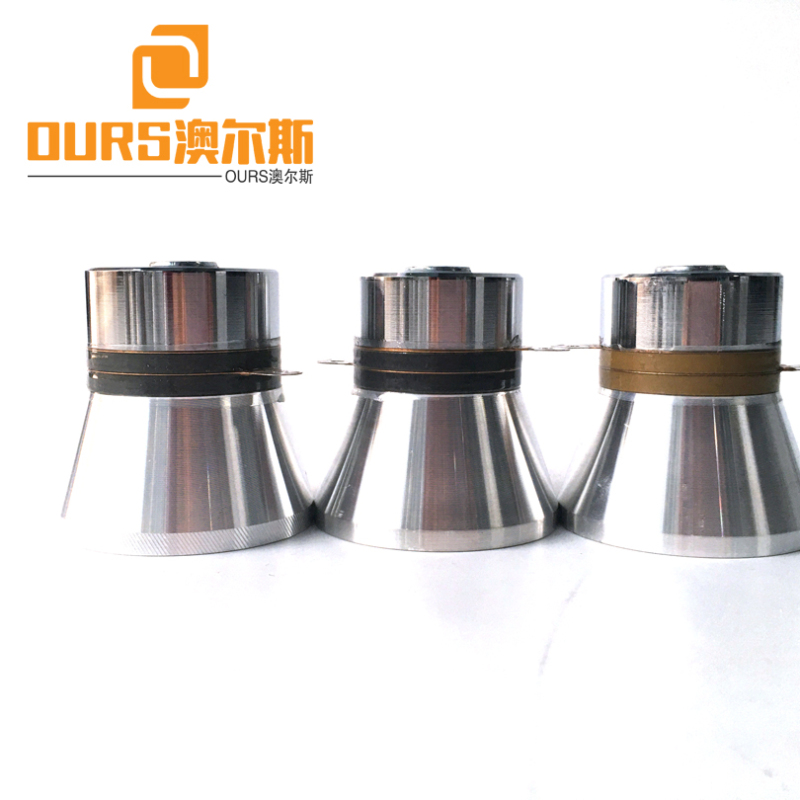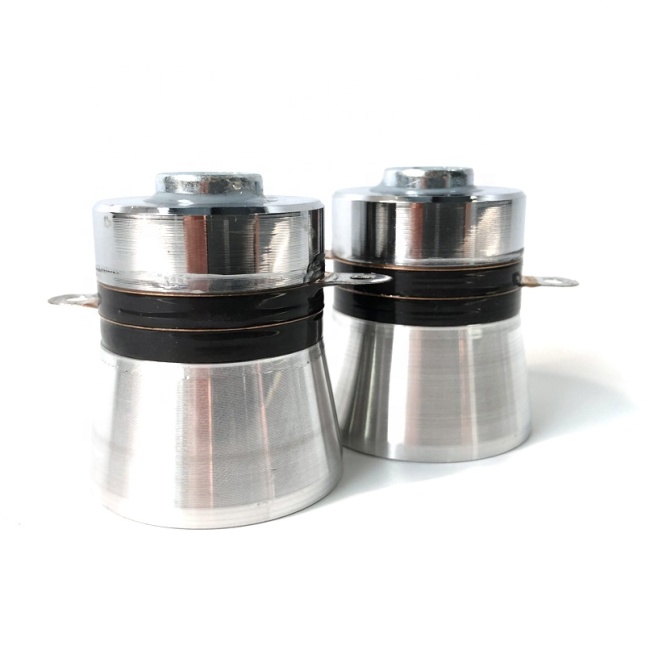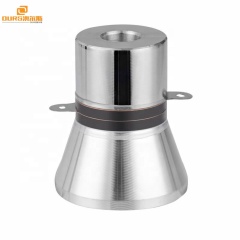28KHZ 100W PZT4 Or PZT8 Piezo Ultrasonic Transducer For Cleaning Engine Parts
1-499 Piece
$9.50
≥ 500 Piece
$9.00
- Item No.202108196f71bMOQ1 Piece
- Product size20 x 15 x 15 cmProduct weight2 kg
Choice
Online customization Customise Now
Customized logo (Min. Order: 1 Piece)
Customized packaging (Min. Order: 1 Piece)
Quantity:

If you have your own design, please contact us, there will have a professional customer service to communicate with you.
Don't have your files right now?No worries, Check out our art tips for more information.
If over 500pcs, mass production will start until pre-production sample has been approved.
Est. 7 days production
28KHZ 100W PZT4 Or PZT8 Piezo Ultrasonic Transducer For Cleaning Engine Parts

The mechanism of ultrasonic cleaning is to make use of the physical effects such as cavitation, radiation pressure and sound flow in the cleaning liquid. It can exfoliate the machinery produced by the dirt on the cleaning parts, and can also promote the chemical reaction between the cleaning liquid and the dirt, so as to achieve the purpose of cleaning the object. The frequency of the ultrasonic cleaning machine can be selected by 10~500 kHz according to the size and purpose of the cleaning material, generally more than 20~50 kHz. With the increase of the frequency of ultrasonic transducer, Langerhans oscillator, longitudinal oscillator and thickness oscillator can be used. In the miniaturization aspect, radial vibration and flexural vibration are also adopted. Ultrasonic cleaning has become more and more widely used in various industries, agriculture, household equipment, electronics, automobile, rubber, printing, aircraft, food, hospital and medical research.
Frequency selection
The transducer frequency is inversely proportional to the wavelength. The wavelength is related to the diameter of the bubble (strictly speaking, it is due to the low frequency of nucleation), and the bubble diameter is related to the explosion pressure. Generally, the higher the frequency, the smaller the wavelength, the smaller the bubble diameter, and the lower the explosion pressure, but the higher the bubble density and the better the permeability.
Based on the above principles:
Low frequency (17~23KHz): If the dirt to be cleaned is heavy or difficult to clean, and the impact of the explosion on the surface of the object to be cleaned is not great, the low frequency series transducer should be selected. Commonly used industries are: magnetic industry, auto industry, textile industry, etc. Note that this series is noisy and is best soundproofed.
Medium frequency (25~28KHz): If the dirt to be cleaned is slightly heavy or the cleaning is difficult, and the impact of the explosion on the surface of the object to be cleaned is not great, the medium frequency series transducer should be selected. This series of industries is the most widely used, common: mechanical processing industry, electroplating industry, catering industry and so on.
Medium and high frequency (33~60KHz): The medium and high frequency series transducers should be selected when the dirt to be cleaned is light, easy to clean, or when the impact of the explosion on the surface of the object to be cleaned is required. Commonly used industries are: precision parts, glass glasses, electronic components, circuit boards, etc.;
High frequency (68-200KHz): The dirt to be cleaned is very light and easy to clean. When it is required to prevent any damage to the surface of the object to be cleaned by explosion, the high frequency series transducer should be selected. Commonly used industries are: semiconductors, special high-precision parts, etc.
Features of ultrasonic vibrator:
1. High performance: high mechanical Q value, high conversion efficiency and good quality;
2. Ultrasonic vibrator transducer has large amplitude and superior performance;
3. Heat resistance of ultrasonic vibrator transducer: Piezoelectric ceramic material has good heat resistance, can expand the temperature range of use, at the same time, the Q value is high, the resonance impedance is small, and the heat generation is small;
4. The appearance of the ultrasonic vibrator transducer is clean, free of rust, no obvious dents and scratches.
The ultrasonic vibrator should be placed in a dry place to prevent the ultrasonic vibrator from getting damp and affecting normal work. If the ultrasonic vibrator is damp, put it in an oven and set about 100 ℃ to dry for 2 hours or use a hair dryer to remove moisture until the resistance value is normal; the ultrasonic vibrator is degummed. After the ultrasonic vibrator is degummed, the output power of the ultrasonic power supply is normal, but due to the vibrator and vibration If the surface connection is not good, the vibrator will be burnt out if you work for a long time. The degumming of the ultrasonic vibrator generally requires a professional ultrasonic manufacturer to repair or replace it.
Maintenance of ultrasonic vibrator:
If you have not used it for more than a week, please cover it with a dust cover (plastic bag); Except that the lifting screw has received lubricating oil before leaving the factory, other parts do not need any lubricating agent; Regularly check the internal vibrator output line for wear; Please wipe the dust with a clean cloth. Dry compressed air should be used to blow away the dust in the machine every six months. It is strictly forbidden to use various fluxes when cleaning the side plate and surface of the welding machine. Neutral detergent should be used and lightly wiped; When the water filter cup reaches 13 water level, please drain the water; every month the welding machine is used, the sliding parts should be wiped clean and re-coated with high-quality lubricating grease; always pay attention to the safety of the machine position.
Ultrasonic vibrator installation process:
1. Preparation tools: Argon arc welding, No. 10 hexagon wrench, chromium iron tin wire, 2.5 square high temperature wire, 2*2.5 cable wire, vibrator glue, (wire stripper, casing, cable tie, sandblasting machine, Pipe fittings, etc.).
2. Welding screws: Calculate the arrangement of the vibrator, weld the screws at the cleaned position, and then clean the surrounding of the screw, be sure to make it flat, so as not to affect the installation of the vibrator.
3. Glue configuration: Squeeze the A glue around the screw, then squeeze the B glue next to the A glue, and then quickly mix the AB glue with a small iron rod to make it fully mixed.
4. Install the vibrating head: twist the transducer a little harder to squeeze out the air and excess glue between the bottom and the contact surface of the cylinder bottom, so that the vibrator is more tightly integrated with the stainless steel.
5. Curing and condensing: curing in a place with relatively high room temperature, 4-8 hours can be connected, 24 hours later, you can power on the test machine.
Note: 1. A metal nail machine can also replace argon arc welding.
2. The welding screws must be fully welded, otherwise they will fall off easily.
3. Regarding curing, temperature should be considered for the length of time. If the temperature is low, the time will be longer, and if the temperature is high, it will be faster. It is recommended to operate at room temperature.
Type | Length(mm) | Weight(g) | Frequency(KHz) | Resonance Impedance | Static Capacity | Input Power(W) |
ARS-QXHNQ28100 | 66 | 625 | 28 | 10-20 | 5200 | 100 |
ARS-QXHNQ28100 | 66 | 624 | 28 | 10-20 | 6600 | 100 |
ARS-QXHNQ30100 | 61 | 555 | 30 | 10-20 | 5200 | 100 |
ARS-QXHNQ2560 | 77 | 530 | 25 | 10-20 | 5400 | 60 |
ARS-QXHNQ2860 | 68 | 470 | 28 | 10-20 | 3800 | 60 |
ARS-QXHNQ2850 | 82 | 425 | 28 | 10-20 | 4100 | 50 |















28KHZ 100W PZT4 Or PZT8 Piezo Ultrasonic Transducer For Cleaning Engine Parts
Send your message to us
No need register, just fill in contact info below, we will reply you within 24 hours!

 English
English German
German French
French Russian
Russian Spanish
Spanish Japanese
Japanese Korean
Korean Portuguese
Portuguese Ukrainian
Ukrainian Arabic
Arabic Italian
Italian






































